![[Metroactive Features]](/features/gifs/feat468.gif)
[ Features Index | Silicon Valley | Metroactive Home | Archives ]
The Secret Garden
Behind the lines at a medical marijuana farm where the operation is successful even when the patients die
Introduction by Kelly Luker/Photographs by George Sakkestad and Jean Hanamoto
LIKE OZ, IT'S AT THE END of a winding road. And like the Emerald City itself, the color green radiates in a shimmering glow. But Dorothy never got a whiff of anything like this. Long before that radiant green comes into view, the pungent odor of marijuana plants telegraphs their presence around the final bend.
This garden of Cannabis sativa, Cannabis indica and Cannabis hybrids hidden in the Santa Cruz Mountains has spared many hours of suffering for patients struggling with cancer, AIDS, multiple sclerosis, glaucoma and a host of other painful--sometimes terminal--diseases. It is the wellspring for Wo/Men's Alliance for Medical Marijuana, one of the most successful medical marijuana programs in the country.
Better known as WAMM, the program was born out of founder Valerie Corral's attempts to alleviate her epilepsy symptoms. Despite numerous medications, Valerie's epilepsy was so severe that she could not be left alone. In 1974, she discovered that marijuana could accomplish what a cabinet full of drugs could not. Valerie and her husband, Mike Corral, began growing their own pot, passing on the excess to others who were ill.
For the next 18 years the Corrals stuck to cultivating a few plants a year to supply themselves and friends. That was until 1992, when they were arrested once, then twice, for cultivation. Both times, their defense rested on their right to grow marijuana for medicinal use. As word of their efforts grew, so did the idea for a medical marijuana program.
Following the passage of Proposition 215 in 1996, a variety of medical marijuana programs or "pot clubs" had sprung up throughout California. However, those programs charged for their services and product, often as much or more than it would cost to purchase marijuana on the streets. And various local and federal law enforcement challenges to Proposition 215 resulted in many of the pot clubs being shut down, including one in San Jose and several others in the Bay Area.
WAMM is unique among its peers in that it is a collective, where members volunteer their time in exchange for the marijuana. For those members too ill to help out--and there are many--there is still no charge. Each week, more than 100 members line up for baggies of pot, pot brownies, cannabis tincture, cannabis liniment and "mother's milk," a soy-based liquid for patients too ill to eat or smoke. The only requirement is a doctor's prescription and space availability in the program. Fortunately, new slots open up on a regular basis. Regrettably, it is usually because another patient has died.
Although the program began under the regime of the conservative former Santa Cruz County Sheriff Al Noren, its growth has been possible because of the working relationship established between the Corrals and Sheriff Mark Tracy. Both the Sheriff's Department and the district attorney's office have turned a blind eye to marijuana growers and users who can show legitimate medical cause.
But although the Santa Cruz populace and its local authorities offer an unusually tolerant atmosphere for medical marijuana, that has been little solace to WAMM in the face of a threatened crackdown by the Bush administration.
WAMM not only survives, it flourishes, just like the secret garden. Pot plants are annuals. They begin life about the size of birdseed and, before the year is out, will reach a height of 6 to 8 feet, with trunks as thick as a man's arm. In those 10 months, each plant will be lovingly tended, closely watched and carefully groomed so it can reach its full potential. Then the harvest comes, and it's over.
The Corrals have lost count of how many terminal patients have come to the program seeking relief before they die.
The cannabis helps, no doubt. But there's something more, something else that allows members to flourish perhaps one last time before the harvest.
"WAMM is not just about medicine," says one member. "It's about caregiving, dignity and compassion."
I've been a WAMM member since 1997. The marijuana helps with the neuropathy, insomnia, diarrhea, muscle spasms and loss of appetite from HIV symptoms. When I came to WAMM, it was like being welcomed to a death reality. It was really harsh. I didn't know how many more times I wanted to get to know people who were going to die. But what I needed was the medical marijuana, and all that was asked of me was to show up.
Now the president says that anyone who smokes a joint is a terrorist. It's horrifying that the president can say something that awful.
When it happens to your own, you will get marijuana for them. You will do what it takes to help them eat, to help them get out of pain.The sick and dying are only asking one thing, to have what they need to treat themselves.
I love the community of WAMM, but with the political climate what it is, I have to think how much of a stand I want to take. But I'll keep taking a stand.
Curtis Caudill, 42
When we grew our first marijuana in 1974, I didn't know the difference between male and female plants. I started reading books and discovered that 90 percent of the information about growing marijuana was bunk. So I tried everything I read and reduced it down to discovering my own methods. It's very much an art and science. There's an intuitive quality to it. I can look at plants and make an educated guess that it's something I want to use as a pollinator.
What we've generally found is that the Cannabis indica strain works better for pain and body discomfort. The Cannabis sativa works better for nausea suppression and appetite stimulation. The indica has more of a tendency to put people asleep. The sativa tends to wake people up. These are just generalities, of course.
Mike Corral, 52
I've been with WAMM four years. I'm a paraplegic, paralyzed from the chest down from a motorcycle accident in 1992. Cannabis controls muscle spasms. A lot of the wheelchair users were using this stuff. I was always telling them, "You're just a bunch of stoners."
One day I woke up in the fetal tuck; I was really spastic that day. A friend came by and burned one with me and I could actually sit up without being thrown out of my chair from the spasms. I said, "This stuff really works," and he said, "Duh."
It was a little epiphany.
I use cannabis on a daily basis. I use it in baked goods and a tincture form which I put in warm milk. Since being a WAMM member, I've been able to secure work as a personal trainer at a local health club. Fitness is my first love. I've been studying fitness, anatomy and nutrition for 25-plus years.
Victor Everlove, 41
I've lost hundreds of friends. The loss doesn't become easier, but it's the greatest time to be in a person's life. It's an honor.
A lot of people, they come to this place where they're not running from the Grim Reaper. They turn around and begin this courtship. Death becomes the lover. In this courtship, so much of the true nature of the person comes to life. It's the most excellent training I could have. Maybe it will help me greet my own death--to court it as a lover and not run in fear.
Valerie Corral, 49
I volunteer my time as a caregiver.
Everyone is expected to work, but many of them are too sick. I'm very healthy, so I can.
There's a lot of people a lot younger than me, but they're so sick. There's people who come up to the farm in wheelchairs to work. There's always stuff for everybody to do. We go up one Saturday a week and work. During the planting and harvesting season, we try to go up a couple of times a week. Mostly it's help working in the garden to keep that going and do volunteer work to raise money. There's a lot of people that need help.
Sometimes just a kind word helps a lot.
Leona Powell, 54
I've been with WAMM for five years. When I was diagnosed with glaucoma, I was taking drops for my eyes, which was just making it worse. I heard that marijuana would relieve pressure on my eyes.
I was raised on a strawberry farm. When I went over to the farm the first time, I'd never seen anything like it. It impressed me so much, and the people were so friendly. Two years ago, they asked me if I would consider working for them part-time.
What I normally do is make marijuana into different forms for ingestion: tincture, hash--ways I can condense it and get the most out of it.
I've put it into caramel candy, ice cream. One little scoop will do ya.
That's one of the biggest requests at the member parties: Did you make the ice cream?
George Hanamoto, 68
Being in the AIDS epidemic, I've been to a lot of memorials. I'm a physician living with AIDS. In 1995, I came down with dysentery and ended up on intravenous fluids. I developed the wasting syndrome, going to the bathroom 15 to 20 times a day, going to bed with diapers. Marijuana saved my life. It allowed me to eat. it kept my spirits up.
I'm both the patient and the doctor. I run a free clinic in the Bay Area. I started a mobile clinic to make home visits.
For better or worse, I can live on SSI and cheap rent. But most doctors with families are very fearful of having their license taken away [if they prescribe medical marijuana]. Also, many aren't attuned to the substance itself.
They've been thoroughly indoctrinated for the past three generations with vicious propaganda against a 5,000-year-old Chinese herbal remedy.
When you get into the history, it's fascinating to see that Prohibition never ended, it just switched from alcohol to marijuana.
Mike Alcalay, M.D., 60
I found out I had AIDS in 1984. I didn't have any energy with the AIDS drugs, and I wasn't getting better. So I refused to take the drug cocktails, and I feel much better now. I feel more alive. The marijuana keeps me with a much better outlook on life.
I work in the garden when I can do manual labor. I can't do a lot of standing. The land needs to be prepared. Some of our land is full of poison oak, so I go and tear it out.
We had a little building that had been here for years for our tools, but we needed more. We all got together and worked and donated to raise enough to put in a building twice as big. We now have a cement floor, windows, an enclosed area for drying our medicine. It dries much better in an enclosed area.
Daniel Rodriguez, 51
Right before the harvest, we have to trim the leaves and get it ready to cut down and dry. It takes several hours per plant to get them ready.
The fan leaves are the first that come off. Right before we take the plants down, we take all the leaves off and all that's left is the bud. The leaves are used for the milk products, the muffins, the tincture.
The majority of the THC is concentrated in the sinsemilla, or female bud. The male has hardly any medical value. Each plant will give us about 2 pounds of buds, on average.
George Hanamoto
We've had so many people in WAMM die, we've learned to accept that pain and suffering are part of this world, that death is part of this life. I would have to say the biggest change in me since working with WAMM, more than acceptance, is that these bodies are impermanent. We are transitory.
Working with WAMM has allowed me to accept my own mortality on a much deeper level. I love life--I'm going to try to live as long as possible--but I do know that somewhere along the line I'm going to die.
Mike Corral
The size of WAMM is determined by the amount of pot available. We have a one-time harvest, which is in October or November. What we harvest there will last the whole year. It's all volunteer, so that's the biggest reason we don't expand.
George Hanamoto
This is my third season with WAMM. I had a stroke in 1997, and I have neuropathy. I use cannabis for pain management, migraines and nausea. I've watched people blossom up here at the farm, from being really sick and not having a very good prognosis to getting healthier and strong. It's therapeutic just being out in the fresh air and interacting with other people.
You are who you are, and the disease becomes something in the background. We become people. Marijuana makes me feel better. It doesn't make me escape this life;
I just feel better. That's not a bad thing.
Diana Dodson, 45
Jean Hanamoto has been working in watercolors and photography for the last 13 years. Since her husband, George Hanamoto, and she became members of WAMM in 1998, Jean has explored marijuana as art, both through photography and computer-enhanced photography. Her work has won awards at the Santa Clara County Fair and the Gilroy City Art Show. More information about Jean Hanamoto and her art can be found at www.marijuana-art.com.
[ Silicon Valley | Metroactive Home | Archives ]
Copyright © Metro Publishing Inc. Metroactive is affiliated with the Boulevards Network.
For more information about the San Jose/Silicon Valley area, visit sanjose.com.
![]()
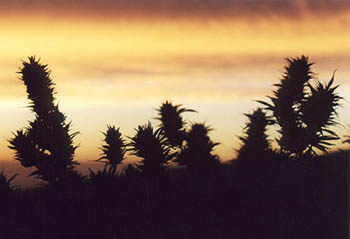
Photograph by Jean Hanamoto
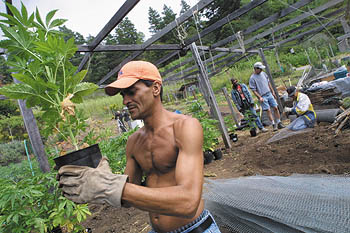
Photograph by George Sakkestad
WAMM member
Up at the farm, late spring

Photograph by George Sakkestad
WAMM co-founder and head gardener
At the farm, late spring
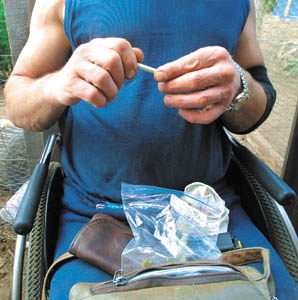
Photograph by George Sakkestad
WAMM member
Up at the farm, midsummer

Photograph by George Sakkestad
WAMM co-founder
Playing a Tibetan instrument at a WAMM member's memorial service

Photograph by George Sakkestad
Volunteer
Up at the farm, late spring

Photograph by George Sakkestad
Garden Coordinator
Up at the farm, late spring
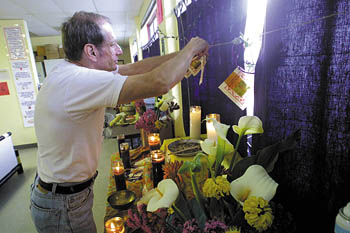
Photograph by George Sakkestad
Supporter
Hanging prayer notes at a WAMM member's memorial service

Photograph by George Sakkestad
WAMM member
Up at the farm, midsummer
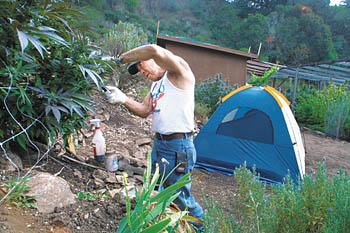
Photograph by George Sakkestad
WAMM Garden Coordinator
Up at the farm, early fall

Photograph by George Sakkestad
WAMM co-founder
Memorial service for WAMM member Jay DeSalvo, May 12, 2001
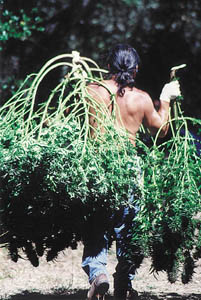
Photograph by Jean Hanamoto
WAMM garden coordinator
At the farm, autumn
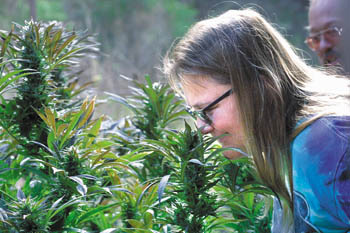
Photograph by George Sakkestad
WAMM member
At the farm, autumn
About Jean Hanamoto
From the March 14-20, 2002 issue of Metro, Silicon Valley's Weekly Newspaper.